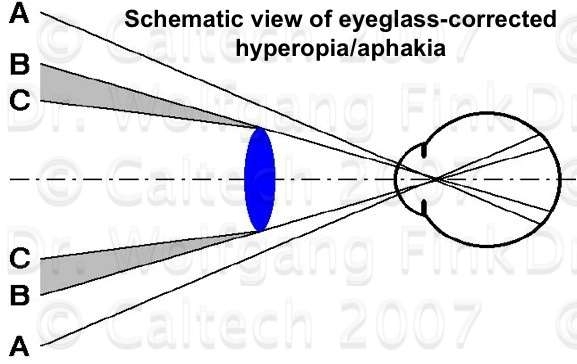Project "Eyemovie": Motion Visualization of Eye Defects
Purpose: To present a highly versatile, objective, and scientific investigational tool for simulation of visual perception under various eye defects or refractive corrections thereof.
Methods: The visual perception under various eye defects introduced into a 3D Gullstrand exact schematic eye model was simulated out of the perspective of a pilot (aviation), a car driver (vehicular traffic), and a pedestrian (pedestrian traffic). For this purpose a movie taken with a video camera was digitized and each frame processed via an efficient and time saving ray tracing technique. The calculations were performed in parallel on a PC-Linux-cluster (30 CPUs for 30 days).
Results: The project Eyemovie is a 50 min computer-manipulated movie (video tape and CD) showing how various eye defects affect the visual perception of a patient. It is the exclusive result of a scientific physical simulation of a 3D human eye model. In particular cataract caused by microvacuoles, diplopia caused by dislocated intraocular lens, annular scotoma caused by eyeglass-corrected hyperopia/aphakia, and diplopia caused by eyeglass-corrected myopia are simulated.
Conclusions: The simulation environment, the project Eyemovie was created in, offers an objective way to actually see how various eye defects affect the visual perception of a patient. It is incomparably more instructive than having the patient describe and explain what he perceives. Aside from being an ideal educational tool the simulation environment represents a highly versatile scientific investigational tool to simulate before and after scenarios as they occur in, e. g., cataract and refractive laser surgery. Given a more advanced eye model adjustable to individually measured biometric and topographic real eye data, much more realistic simulations may be performed: effects of refractive laser surgery techniques, tear film distortions (dry eyes), multi-focal IOLs, etc.

Normal vision
Place your mouse over the image to see:
Cataract due to microvacuoles inside the eyelens

Normal vision
Place your mouse over the image to see:
Vertically dislocated intraocular lens (IOL) after cataract surgery

Normal vision
Place your mouse over the image to see:
Hyperopia (farsightedness) due to Aphakia (lack of eyelens) corrected with eyeglass

Normal vision
Place your mouse over the image to see:
Myopia (nearsightedness) corrected with eyeglass
Detailed Description
Introduction
In 1909 Alvar Gullstrand introduced his human eye model called the "exact schematic eye". This optical eye model augmented by an iris that allows for variable pupillary diameter was implemented on a computer [1, 2].
Using a special technique of ray tracing, still-images can be calculated that simulate the visual perception of a person suffering from various eye defects (e. g.: myopia, hyperopia, dislocated/tilted intraocular lens (IOL), eyeglasses, contact lenses, combination of eyeglass & contact lens, and cataract, etc.) [1-3].
Project Eyemovie
More instructive than still-images are pictures in motion. This is the novel approach that has been taken in the project Eyemovie: Introducing various eye defects into the above eye model (e. g.: cataract, dislocated intraocular lens (IOL), eyeglass-corrected hyperopia due to aphakia (lack of eye lens), eyeglass-corrected myopia), a tensor/matrix for image manipulation based on a proprietary version of the ray tracing simulation has been calculated rather than individual still-images.
A movie taken with a video camera was then digitized and each frame was processed by the tensor/matrix as shown above to result in a computer-manipulated picture, thereby circumventing the very time consuming ray-tracing simulation that would normally have to be applied to each individual frame. The calculations were performed on a Linux PC-cluster (30 days on 30 CPUs in parallel).
It should be emphasized that the project Eyemovie is a computer-manipulated video movie that is the exclusive result of a scientific physical simulation of a 3D human eye model and NOT the result of a computer graphics program!
Example applications already developed
1. Normally, what a patient with a visual defect sees cannot be seen by the doctor. The patient has to say what he sees. This is no longer true in a rigorous sense. The project Eyemovie is an almost full-length, computer-manipulated video film which shows how different eye defects affect the visual perception of a patient. This allows the patient to let the examining doctor "see" what he actually sees. It is incomparably more instructive than having the patient describe and explain what he perceives.
2. Another novelty of the Eyemovie simulation is that for the first time the visual perception under one form of cataract is simulated, namely cataract caused by microvacuoles.
3. The project Eyemovie is an ideal educational tool for clinical personnel, medical students, medical doctors, and patients suffering from eye-diseases. It is also applicable for school-education and as an informational tool for elderly people.
4. The project Eyemovie is a highly versatile scientific tool for simulation of visual perception under various eye-defects from different perspectives: of a pilot, a car driver, and a pedestrian. This is of major importance for aviation, vehicular traffic, and pedestrian traffic.
Relevant Publications
1. Fink W (1997) Anwendung theoretisch-physikalischer Methoden in der Ophthalmologie (Application of theoretical-physical methods in ophthalmology), Dissertation, Institute for Theoretical Physics, University of Tübingen
2. Fink W, Frohn A, Schiefer U, Schmid EW, Wendelstein N (1996) A ray tracer for ophthalmological applications, Ger J Ophthalmol 5 118
3. Fink W, Frohn A, Schiefer U, Schmid EW, Wendelstein N, Zrenner E (1996) Visuelle Wahrnehmung bei hohen Ametropien - Computergestützte Simulation mittels strahlenoptischer Rechnungen, Klin Monatsbl Augenheilkd 208 472
Wolfgang Fink, Ph. D.
Senior Researcher at Jet Propulsion Laboratory (JPL)
Visiting Research Associate Professor of Ophthalmology at University of Southern California (USC)
Visiting Research Associate Professor of Neurosurgery at University of Southern California (USC)
Visiting Associate in Physics at California Institute of Technology (Caltech)
Mailing Address:
California Institute of Technology
Visual and Autonomous Exploration Systems Research Laboratory
15 Keith Spalding (corner of E. California Blvd & S. Wilson Ave)
Mail Code 103-33
Pasadena, CA 91125
USA
Phone: 1-626-395-4587
Fax: 1-626-395-4587
E-mail: wfink@autonomy.caltech.edu.

